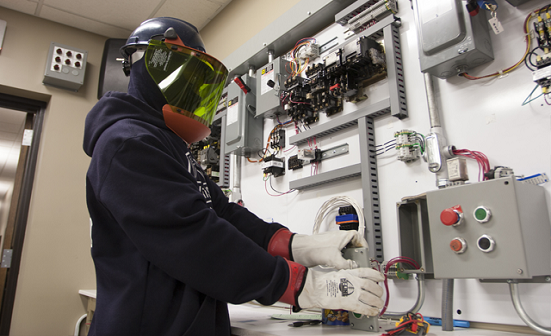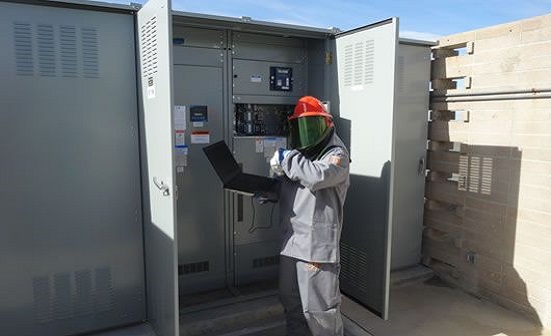Arc Flash PPE
To ensure a healthy work place, it involves the provision of instructions, procedures,training and supervision to the employees against the hazards. Risk due to Arc flash explosion is high, its effect is to be assessed by the employer. An electric arc is a visible plasma discharge between two electrodes that is caused by electrical current ionizing gases in the air. Loose connections, Insulation failure, improper maintenance of equipment, Conductive Dust an impurities, Short Circuits and Corrosion of conducting parts can create an electric arc. An arc flash is a type of electrical explosion that results from a low impedance connection to ground or another voltage. Arc flashes reach to 35,000°F easily causing severe injuries,Arc flash accidents cause roughly 80% of professional electrical injuries that occurs across the world each year. The large amounts of light and heat given off by an arc flash have the potential to destroy skin, cause severe burns and eat away tissues.
NFPA (National Fire Protection Association) proposed PPE (Personal Protection Equipment) to all affected employees for the protection against arc flash hazard . Personal protective equipment (PPE) refers to protective clothing, helmets, goggles, or other garments or equipment designed to protect the wearer's body from injury or infection. The hazards addressed by protective equipment include physical, electrical, heat, chemicals, biohazards, and airborne particulate matter. To know when arc flash PPE is required, an Arc flash Risk Assessment test has to be performed, there by evaluating the incident energy present at particular entity. Incident energy is the energy impressed on the employee when an arc flash explosion occurs. It is measured in Cal/cm^2. An arc flash PPE requirement chart has been laid down in the NFPA 70 E 2015 representing four arc flash hazard categories, based on the incident energy liberated in an arc flash situation. NFPA also proposed Table method, an equally accepted method based on short circuit and protective device values provided. The table method is simpler than the arc flash calculation method. But many Professionals prefer arc flash calculation method to table method, since table method does not identify other short-circuit and coordination hazards that may be greater than the arc flash hazards list in the table method.
In the First PPE category untreated natural fiber shirt (long sleeves), Pants (long), balaclava, face shield, safety glasses, leather footwear, rubber insulating gloves and hearing protection are recommended. For the next two Categories Arc rated Gloves, arc rated suit hood, arc rated face shield, arc rated hard hat, safety glasses, hearing protection, leather footwear are advised. Arc-rated protective clothing protects from arc flash and electric arc hazards. Arc-rated garments are measured in Cal/cm². It is required to determine necessary arc protection levels and to insure that proper personal protective equipment is worn from arc flash PPE table.
| PPE Category | Incident Energy From (Cal/cm2) | Incident Energy To (Cal/cm2) | Required Min. Arc rating of PPE (Cal/cm2) |
|---|---|---|---|
| 1 | 0 | 1.2 | 1.2 |
| 2 | 1.2 | 12 | 12 |
| 3 | 12 | 40 | 40 |
| 4 | 40 | More Than 40 | Dont work live |
(Table1: PPE Categories based on Incident Energy Level)
Any material or Product is tested before its use similarly using Arc flash kit Arc flash PPE is tested to determine the material's response to an electrical arc event by establishing an arc rating (i.e., a value attributed to materials describing their performance in an arc flash hazard). There are several different test methods written around in NFPA, including those used to evaluate electrical flash clothing (ASTM F1506, ASTM F1959, IEC 61482-2, IEC 61482-1-1 and IEC 61482-1-2), garments (ASTM F2621 and IEC 61482-1-1 Method B), gloves (ASTM F2675), face and eye protection (ASTM F2178), blankets (ASTM F2676), and other products a worker with potential exposure to electrical arc hazards may use.
| Equipment | When to test |
|---|---|
| Gloves | Before first issue and every 6 months after that |
| Suit, and other garments | Before first issue and every 1 year after that |
| Footwear, Hard hat | Upon indication that insulating value is devalued |
(Table2: Protective Equipment Testing Schedule)
Proper Maintenance, improves the durability of any product. Every Arc flash safety equipment should be cleaned with warm water using a mild soap once in a month, don’t use any other chemicals that effect the insulation properties of garments. After every use PPE should be stored properly. An employee should have minimum knowledge on how to handle PPE. As per sec. 1910.132(f) of NFPA 70E 2015, “The employer shall provide training to each employee who is required by this section to use PPE.Each such employee shall be trained to know at least the following:
When the employer has reason to believe that any affected employee who has already been trained does not have the understanding and skill required, the employer shall retrain each such employee. The employer must issue a written “training certificate” which must include, name of each employee trained, date(s) of training, and Identity of the subject covered. Each affected employee shall demonstrate an understanding of the training specified, and the ability to use PPE properly, before being allowed to perform work requiring the use of PPE”.
Arc flash protection requirements are nothing new in the industry. The process of identifying arc flash protection requirements is prescribed clearly in NFPA 70E and all arc flash safety equipment required shall be identified by conducting arc flash study for the electrical network and electrical arc flash suit for the respective energies.
Arc flash and shock hazard labels need to be prepared printed and pasted on the panels in a clearly visible format mentioning the incident energy, category (ex: cat 4 arc flash suite ) and respective arc flash PPE (arc flash balaclava, arc flash coveralls electrical arc flash suit etc.) Incase of the system is falls under cat4 arc flash suite required arc flash balaclava and arc flash coveralls shall be clearly mentioned in the arc flash and shock hazard labels and these arc flash balaclava and arc flash coveralls shall be made available to the working personnel for energised working conditions. These arc flash safety equipment are already available in the market for respective energy levels.







